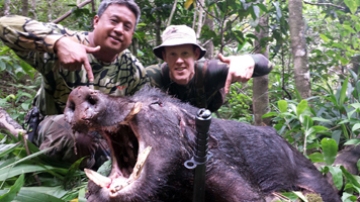Stalking and shooting boar, or feral pigs, is a sport in Hawaii with  environmental benefits. The wild pigs cause damage to the islands’ rainforests and crops, and hunting keeps the population under control. Hook You Up Outfitters offer boar hunting trips on the Hawaiian islands. Owner/outfitter Sonny Thater and client Chris Cole (see photo)show off their boar.The act of roaming the wild in search of meat entices locals and tourists alike. Three Seventy Common Chef-Proprietor Ryan Adams describes the experience.
environmental benefits. The wild pigs cause damage to the islands’ rainforests and crops, and hunting keeps the population under control. Hook You Up Outfitters offer boar hunting trips on the Hawaiian islands. Owner/outfitter Sonny Thater and client Chris Cole (see photo)show off their boar.The act of roaming the wild in search of meat entices locals and tourists alike. Three Seventy Common Chef-Proprietor Ryan Adams describes the experience.
While living in Hawaii he and few friends often hunted boar. Depending on the day and location, “It could take hours or just minutes. Or never,” Adams says to track and slay a boar. “After that there is a lot of time needed for cleaning and prepping. It takes a good 5 days before being ready to cook.” The animal must be cleaned, seasoned, wrapped and trussed. Digging the roasting pit, or imu, is an additional job.
When ready to cook, “We rub the whole boar down with soy sauce,” he explains. Sugar, Hawaiian sea salt, pineapple and peppercorns are some of the most traditional seasonings. Lava rocks are heated and placed in the pit. The boar is wrapped in chicken wire and placed over several layers of banana leaves and burlap. “Finally it is topped with sand and/or clay, so when it bakes the space turns into a giant ceramic oven,” Chef Adams says. “A vent allows the pig to breathe’,” he adds.
Cooking will take from eight to twelve hours depending on the size of the pig. “The ones I’ve prepared weighed between 90-200 pounds,” says Chef Adams, who recommends using leather work gloves, an instant-read thermometer, very large tongs, forks and knives.
The boar must stay sealed to cook properly. “One time someone fell in the pit and let all the heat out, so the animal never got cooked all the way through,” he recalls.
Successful and unsuccessful hunts end with plenty of beer. And for the hunter that made the kill? “The tusks are the reserved prize.”











